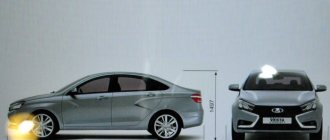With modern capabilities, the range of the current automobile industry is trying to please any, even the most capricious client. The Lada Vesta model range is proof of this. The layout and volume of the trunk are often important for car owners; all people pay attention to such details. Especially planning that the car will often be used to transport large cargo. The buyer has an individual list of criteria for choosing a car. The Lada Vesta model under consideration, in particular the SV cross version, is positioned as a universal car, its trunk volume is large and can accommodate a lot of things.
- Trunk of station wagon and Cross version - interesting observations
- The layout of the car trunk - the convenience of the organizer
- Sedan trunk volume
- Trunk of the CNG modification - why can’t you put a lot in it?
- Are the luggage racks better than competitors?
Trunk of Lada Vesta (sedan)
The trunk volume of the Lada Vesta, according to the AvtoVAZ plant, is 480 liters, which is quite a lot. Allows you to load almost any household item, including large household appliances, garden tools or construction equipment.
Lada Vesta with an open trunk. Photo source: https://www.drive2.ru/o/b/477728182615670898
For comparison, the trunks of other models of the same plant are as follows:
- Priora: sedan - 430 l, station wagon - 444 l, hatchback - 360 l.
- Kalina: hatchback – 240 l, station wagon – 355 l.
- Granta: sedan – 520 l, hatchback – 440 l.
- Largus: station wagon - 2350 l, van - 2540 l.
Thus, the trunk volume of the Lada Vesta in liters, although much inferior to the Largus (which was initially positioned as a cargo-passenger version). However, it is only slightly smaller than the Granta sedan and significantly ahead of Kalina and Priora.
The ability to transport oversized cargo increases even more if you fold down the rear seat backrest. The Vesta station wagon's interior allows you to do this completely - when the backrests are lowered, the rear seats fold in the same plane as the trunk floor (in the sedan there is a 10-centimeter step). In the resulting free volume you can place long things: skis and fishing rods, gardening tools (rakes with shovels, seedlings) and even bicycles.
Even the refrigerator fit. Photo source: https://www.drive2.ru/l/506201410606466102/
If even this size is not enough, it is additionally possible to recline the back of the front passenger seat. Then, in the cabin of a regular Vesta sedan it is possible to transport things longer than 2 m, such as slats and baseboards for repairs, rolled up carpets and similar utensils.
In order to represent the dimensions of the luggage space of the Vesta sedan even more accurately and not end up in an unpleasant situation when an item purchased in a store does not fit in the car, independent auto experts took measurements. Here is their result:
- The length of the luggage compartment is 96.2 cm, with the rear seatbacks folded down – 167.5 cm.
- Width: maximum – 142.4 cm, minimum – 103.9 cm.
- Height with lid closed – 57.3 cm.
The loading height to which the cargo will have to be raised when placing it in the car is 71 centimeters.
If there is an urgent need to transport an even larger load, it is possible to dismantle the false floor of the spare tire compartment. If you remove the spare wheel itself, an additional volume of 95 liters will be freed up, which will increase Vesta’s trunk to a total of 575 liters.
Interior dimensions
The auto magazine Auto Review showed how spacious it is in the Vesta’s cabin when comparing it with its competitors:
- height from driver's seat cushion to ceiling - 939-990 mm.
- height from the rear passenger seat cushion to the ceiling is 896 mm.
- the distance from the back of the front seat to the legs of the rear passenger is 226 mm.
- The length of the front seat cushion is 450 mm.
- The length of the rear seat cushion is 480 mm.
The diagram also shows the weight distribution along the axes:
- front axle - 60.9%.
- rear axle - 39.1%.
AvtoVAZ data is highlighted in red, Autoreview measurements are highlighted in black.
ZaRulem journalists also made similar measurements:
Sedan
For starters, a pioneer. Vesta was first presented in a sedan body. Happened in August 2014. Full-scale production began in September 2015. And 2 months later the sedan went on sale.
The three-volume model is offered with a trunk capacity of 480 liters. The backrest can be lowered, allowing you to transport long loads.
This is, of course, not the compartment in the Skoda Octavia. But still not bad. Let's be frank.
What about competitors?
The cargo compartments of the Datsuns have a good flat floor and a low loading height, but the arches here protrude too much, and the width of the opening leaves much to be desired. The situation is even worse with the Solaris' trunk, which (with the smallest volume among sedans) has one of the largest wheel arches, which forced the developers to create a complex sidewall geometry.
Trunk Hyundai Solaris sedan
However, this is partly offset by a flat floor, neat hinges, a large opening, and a low loading height. The Rio platform brother offers the same set of pros and cons, but its useful volume is noticeably larger.
Trunk Kia Rio sedan
In addition to the above-mentioned advantages of competitors' trunks, Rapid also offers a convenient door lid, the opening of which creates the largest loading opening in height. The downside is that it is slightly higher than the other participants in the comparison.
In turn, Logan’s “bins” are close in layout to Vesta and have a similar “disease” in the form of massive hinges. In addition, Logan has a less convenient loading opening, as well as more prominent wheel arches.
Renault Logan sedan luggage
Trunk volume Lada Vesta 2015, 1st generation, sedan
The model is produced from 09.2015 to the present time
. Read the review of Lada Vesta 2016.
| Equipment | Trunk capacity, l | Volume with 2nd row seats folded, l | Seat folding proportion |
| 1.6MT Classic | 480 | — | 60/40 |
| 1.6MT Classic Start | 480 | — | 60/40 |
| 1.6MT Comfort | 480 | — | 60/40 |
| 1.6 MT Comfort Image | 480 | — | 60/40 |
| 1.6 MT Comfort Multimedia | 480 | — | 60/40 |
| 1.8MT Comfort | 480 | — | 60/40 |
| 1.8 MT Comfort Image | 480 | — | 60/40 |
| 1.6MT Luxe | 480 | — | 60/40 |
| 1.6 DSG Classic Start Plus | 480 | — | 60/40 |
| 1.8MT Luxe | 480 | — | 60/40 |
| 1.6 MT Luxe Multimedia | 480 | — | 60/40 |
| 1.6 MT Luxe Prestige | 480 | — | 60/40 |
| 1.6 DSG Comfort | 480 | — | 60/40 |
| 1.8 MT Luxe Multimedia | 480 | — | 60/40 |
| 1.6 DSG Comfort Image | 480 | — | 60/40 |
| 1.6 DSG Comfort Multimedia | 480 | — | 60/40 |
| 1.6MT Exclusive | 480 | — | 60/40 |
| 1.8 MT Luxe Prestige | 480 | — | 60/40 |
| 1.6 DSG Luxe | 480 | — | 60/40 |
| 1.8MT Exclusive | 480 | — | 60/40 |
| 1.6 DSG Luxe Multimedia | 480 | — | 60/40 |
| 1.6 DSG Luxe Prestige | 480 | — | 60/40 |
| 1.6 DSG Exclusive | 480 | — | 60/40 |
| 1.6 CVT Comfort Image | 480 | — | 60/40 |
| 1.6 CVT Exclusive | 480 | — | 60/40 |
| 1.6 CVT Luxe Prestige | 480 | — | 60/40 |
| 1.6 CVT Classic Start | 480 | — | 60/40 |
| 1.6 CVT Comfort | 480 | — | 60/40 |
| 1.6 CVT Luxe Multimedia | 480 | — | 60/40 |
| 1.6 CVT Comfort Multimedia | 480 | — | 60/40 |
| 1.6 CVT Luxe | 480 | — | 60/40 |
| 1.8 DSG Luxe | 480 | — | 60/40 |
↑ Body characteristics and dimensions
In the manufacture of the body of the new Lada, exclusively high-strength steel alloys are used; it was decided to do without aluminum and other expensive materials, which are popular in the modern automotive industry. This approach made it possible to offer one of the most competitive prices in class B+ in comparison with foreign models, as well as to make the body as rigid and safe as possible, with a minimum of vibrations and extraneous noise.
When producing Vesta, AvtoVAZ uses new design technologies and the selective inclusion of high-strength special alloys in the body structure. Thanks to this, it is possible to avoid deviations in the geometry and dimensions of the body, prevent door skewing, and ensure good handling.
Initially, it was planned that the new model would replace the Priora in the VAZ line, although in all respects the new model is superior to the Tolyatti bestseller.
Main dimensions of Lada Vesta, meters:
- height – 1.497;
- body length – 4.41;
- wheelbase - 2.635;
- body width – 1.764;
- front track width – 1.5;
- rear track width - 1.51;
- turning radius – 5.2;
- aerodynamic drag coefficient – 0.82;
- ground clearance - 0.171.
AvtoVAZ specialists, when designing the overall dimensions of the Lada Vesta, were guided by its subsequent operation in domestic conditions, so the car is ideal for traveling on Russian roads. For example, thanks to the increased wheelbase, the car has excellent directional stability and controllability even on uneven road surfaces. A sufficiently high ground clearance makes it possible to overcome difficult sections of the road that many competitors cannot overcome.
Suspension and brakes
The Lada Vesta has a new MacPherson type front suspension, which is mounted on a subframe. The engine mounts and the electric power steering rack are now mounted on it (previously it was located higher, which caused a lot of inconvenience). The independent suspension is equipped with L-shaped arms and steering knuckles, the angle of inclination of the axle turning the wheel is five degrees. This is a completely new solution for VAZ with telescopic shock absorbers (hydraulic or gas), springs and anti-roll bars. The Vestov chassis will give a head start to any foreign car in the middle segment.
The rear suspension is semi-independent, spring with shock absorbers, borrowed from Renault Megane. All modifications of Vesta are produced with dependent rear suspension; AvtoVAZ plans to have an all-wheel drive vehicle; there is no exact release date yet.
The braking system of the car is liquid, disc brakes at the front, drum brakes at the rear. The Lada SV Cross has all disc brakes. The chain was completely taken from the Renault-Nissan concern.
More about the design and interior
Lada Vesta has a good interior, which is decorated with soft plastic. Despite this property, the plastic is quite durable. The interior of the car is upholstered in fabric and black leather. Added silver inserts. The panel is decorated with two backlight colors. It contains the necessary sensors: speedometer, tachometer, fuel level and engine temperature. The interior of the “luxury” version of the Lada is made at the level of higher-class European cars, which is a pleasant surprise.
Lada Vesta takes the Russian auto industry to a new level. This could not but affect the features of the car body, which allows Lada to compete for leadership in the market with foreign competitors. The car has respectable dimensions and relatively light weight. This is complemented by good aerodynamics and a high level of passenger safety.
What's new in the salon?
Although Vesta’s interior has not changed much compared to the sedan, some elements that car owners complained about have been improved. Perhaps the most discussed point is the new armrest, which has become more beautiful and practical. On the Cross version it is stitched with orange stitching, matching the body color. The same color is used on other interior elements - seats, doors, center console. In addition to orange, gray will also be offered; other variations are not yet known.
Armrest
Other improvements include 3-stage heated seats, a micro-lift of the glove compartment lid, inside of which there is an organizer with a cup holder. On the Cross version of the Lada Vesta, the dials on the instrument panel are made in bright orange, some will probably like it, others will consider it unnecessary, but overall it looks at least original.
Will 4 wheels fit into the trunk of Vesta?
Among those interested in cars, they argue about the merits of different models, using arguments that are not always clear to the uninitiated. One of the prejudices was the opinion that the trunk of a car is good or bad depending on whether it is possible to fit a spare set of tires in it.
The trunk of the Lada Vesta sedan successfully passes this unofficial test. All 4 standard wheels are loaded into it.
Photo from the forum of Lada Vesta owners as confirmation - four wheels of size 185/65 R15 in the trunk of the sedan. There is free space left for the tool:
4 wheels in the trunk. Photo source: https://www.drive2.ru/l/512298202582483869/
Winter tires on standard alloy wheels 195/55 R16. The trunk lid closes without problems.
Station wagon (SW)
Now about the trunk of the Lada Vesta station wagon.
Interestingly, we had to wait almost 2 years for the premiere of this body type. We presented a new product and also launched production in the summer of 2017.
In the normal position of the rear sofa up to the shelf there is a capacity of 480 liters. But if you load it under the ceiling, the volume will be 2 times larger.
Another 95 liters are available under the flooring in a special first niche. The second niche is used for a full-size spare wheel.
The rear seat lowers. As a result, the total trunk volume of the Lada Vesta station wagon is 825 liters. The only drawback is that a flat platform is not formed.
But still, the trunk dimensions of the Vesta SV are quite good. But the luggage compartment of the Lada Largus Vesta SW is far away.
Trunk of station wagon and Cross version - interesting observations
Automotive designer Steve Mattin, who works at VAZ, claims that when creating the Vesta Sw station wagon, they designed a rear window model with a slope, which directly affected the volume of the trunk. If a station wagon is maximally identified with a sedan, then the trunk volume of the Lada Vesta SV Cross is almost the same, amounting to 480 liters. Removing the raised floor reveals an additional 95 liter compartment. In this parameter, the Cross version of the car does not differ from the Sw.
Transportation of large cargo is required; just fold the rear seat and we get a trunk compartment with a nominal capacity of 825 liters. The key parameters of the trunk opening are width and height. The first is 1000mm, and the second, respectively, is 860mm.
The dimensions of the trunk of the Lada Vesta SV are as follows (a×b×h): - shortest length (close to the rear seat) - 930 mm;
- largest (a) (close to the front seat) - 1820 mm;
- smallest (b) (between arches) - 980 mm;
- largest (b) (including 2 niches) - 1340 mm;
- largest (h) - 830 mm;
- smallest (h) - 660 mm;
- (h) threshold - 110 mm.
They are similar for the station wagon and Cross version.
The layout of the car trunk - the convenience of the organizer
The main role in the ease of use of the luggage compartment is played by a thoughtful layout of the space. The SV Cross station wagon is well equipped. Car enthusiasts are interested in a double floor with a box built into the trunk for various small items needed by the driver. The trunk organizer is a new solution; it wasn’t installed anywhere before 2180! This niche consists of two plastic drawers, which are covered with floor panels. Each section is fixed vertically, which allows you to zone the available space separately. The floor panels and organizer are removable, increasing the cargo capacity.
The cargo transported in the trunk of the Vesta SV cross can be secured; for this purpose, three nets are provided. The side panel on the right provides an irreplaceable detail - a lockable tool box, and on the left - a pocket that can accommodate a 5-liter bottle. There are four hooks on the trunk upholstery for various packages. The spare tire is located under the second floor and does not take up space. For lighting, there are two light bulbs on the sides, and a 12-volt socket is provided. For easy access, there is a button for opening on the outside of the trunk lid, and two handles inside. The luggage compartment of the Lada Vesta SV Cross is designed and equipped for easy operation.
What can be improved in the luggage compartment of a Lada Vesta car
The trunk lid is lifted manually, which is not very convenient. Some car owners solved this problem radically by installing gas struts on it. These devices are also installed on the hood, because the poker can fail at any moment, and it’s not very pleasant when something hits you on the back. And a poker that pops out, or the hood can hit. This modification of the front and rear body covers makes the life of the car owner much easier. Gas struts lift the trunk roof when your hands are busy, and hold the hood roof suspended when you need to check the spark plugs or tinker with the engine without fearing for the integrity of your own back.
Another problem that Lada Vesta owners have encountered is water and dirt getting into the engine compartment and trunk. This happens when washing a car under high pressure water, when it rains or snow melts. This problem can be solved by modifying the seals and installing them in the lock area, in the locations of the headlights. Moreover, seals can be installed not only standard automobile ones. Roofing seals, which are produced on adhesive tape and hold well, can also solve the problem.
Car owners block access to water flowing from the glass into the body with plastic silicone sealant.
When choosing a new car, the least attention is paid to trunk volume. However, there are drivers for whom even the layout of the cargo compartment is important. For example, such a need arises during frequent city-dacha route travel. Lada Vesta, the trunk volume of which is already known in various trim levels, is positioned as a universal car. To evaluate the characteristics of each model, you should analyze them.
Comparison of Vesta with other models of modern AvtoVAZ cars
For comparison, here are some numbers regarding the trunk.
But in both the sedan and station wagon, the seats conveniently fold forward, thereby increasing the volume of the luggage compartment by 250-300 liters, respectively.
Lada modelsCharacteristics of the cargo compartmentParameters in other cars
The Vesta sedan has a cargo compartment volume of 480 liters, which is the same as the Renault Logan. It should be noted that Vesta’s luggage compartment, the shape of the hinges on the lid, and the lid itself have a common outline with the Renault Logan sedan. Vesta’s predecessor, the Lada Priora, has a size of 430 liters. The luggage compartment capacity is the same as the Daewoo Gentra. The leaders in luggage capacity are the Hyundai Solaris and Skoda Rapid, having a space of 510 and 530 liters, respectively. The Datsun on-Do has the same capacious trunk. The cargo part of the Lada Vesta station wagon model, the release of which all fans of AvtoVAZ cars are still waiting for, will accommodate, according to the developers, 500 liters of cargo.
The luggage compartment of the Lada Vesta in the hatchback assembly will be significantly smaller - only 400 liters.
What will the new Vesta please you with?
An important characteristic of the trunk is the layout of the space. Lada Vesta, whose trunk volume has increased significantly in recent years, provides the buyer with a design with a completely flat floor. There is space underneath for a spare tire. Thanks to the wide opening, loading large cargo is easy. It is worth considering cars with 3 body types:
The trunk of the future Lada Vesta station wagon especially stands out. It is expected to increase to 500 liters. The slope of the rear window above the trunk smoothly merges into the bumper. This expands the machine's load capacity.
Vesta Cross offers motorists a convenient luggage compartment with a curtain, smooth side walls and mounting rails. The protective finish on the threshold allows you to load heavy items without fear. The trunk volume is expected to be between 500-520 liters. You can appreciate its parameters from the presented photos.
The luggage compartment of the Lada Vesta hatchback, judging by the performance characteristics of its main competitors, will be equal to 400 liters. It is planned to include a lock with an electric drive in the package. The headlights are conveniently located on the opening luggage compartment lid.
Disadvantages of the trunk of Lada Vesta (sedan)
Many Vesta owners complain in the forums about the design of the double floor of the spare tire niche that was not thought out by the factory, leaving a lot of free space.
Another common complaint is that the height of the sill formed by the rear panel of the body makes loading and unloading heavy cargo very difficult.
They mention the traditional problem with leaking seals, due to which water accumulates in the spare tire niche after high-pressure washing. Work on eliminating seal leaks on your own is a separate genre of garage witchcraft; for some owners it lasts for months.
There is a separate question about the modification with Vesta CNG gas equipment, the trunk of which has been greatly reduced due to the installed 90-liter cylinder. From the rear panel to the protective casing of the cylinder there is only about 50 cm, and the opportunity to increase space by folding the seat back is blocked.
Therefore, the most that the owners of the gas Vesta can count on is space for a couple of bags from the supermarket. They have to think about alternative options for transporting cargo.
Is it possible to put a roof rack on Vesta (sedan)
The only way to increase the carrying capacity of Vesta without purchasing a trailer is to install a luggage box on the roof. The manufacturer did not formally agree on this, but on the Lada website they offer to buy a set of transverse bars for installation.
Autobox on the roof of Vesta. Photo source: https://www.drive2.ru/l/494336305753227994/
Unlike modifications with a station wagon body, the sedan does not have an integrated roof rail to which such crossbars can be attached - they are installed with fastenings in the door openings.
The Lada Vesta trunk is made by domestic manufacturers:
- Trademark LUX from Moscow.
- Petersburg, producing products under the Atlant brand.
- Products "Eurodetal" from Rostov-on-Don.
Craftsmen install imported universal-class car racks on the roof of Vesta sedans: Wingbar from Thule (Sweden), Turtle Air-2 from Can Otomotiv (Turkey), Menabo Lince (Italy). The price of a domestic set of cross rails for a smooth sedan roof is in the range of 4-6 thousand rubles, imported - from 9 to 20 thousand.
Comparison with competitors
Vesta's competitors include:
Let us remind you that the trunk volume of a Russian car is 480 liters for both a sedan and a station wagon. In Renault Logan, the volume of this department reaches 510, and in Rio - 500 liters. Solaris will allow you to load only 470 liters of luggage, although both of these models are created on the same platform. The leaders in trunk capacity are the Skoda Rapid and Datsun, which hold 530 liters.
If we compare the features of the luggage compartments, then the Datsuns also have a good and flat floor, and the loading height is optimal. But the arches in Datsuns protrude too much, and the opening width is not enough to load particularly large items.
In this regard, the Solaris trunk causes the most inconvenience: the wheel arches here are the largest, which does not have the best effect on the geometry of the sidewalls. These shortcomings are somewhat concealed due to neat hinges, a flat floor, low loading height and a large opening. Rio, created on the same site as Solaris, has the same advantages and disadvantages, but the usable luggage compartment volume of this car is larger.
Specifications
| COMMON DATA | Lada Vesta SW 1.8 5MT (5AMT) | Lada Vesta SW 1.6 5MT (5AMT) | Lada Vesta SW Cross 1.8 5MT (5AMT) | Lada Vesta SW Cross 1.6 5MT |
| Dimensions, mm: length / width / height / base | 4410 / 1764 / 1512 / 2635 | 4410 / 1764 / 1512 / 2635 | 4424 / 1785 / 1532 / 2635 | 4424 / 1785 / 1532 / 2635 |
| front/rear track | 1510 / 1510 | 1510 / 1510 | 1510 / 1510 | 1524 / 1524 |
| Trunk volume, l | 480 / 825 | 480 / 825 | 480 / 825 | 480 / 825 |
| Ground clearance, mm | 178 | 178 | 203 | 203 |
| Curb weight, kg | 1330 | 1280 | 1350 | 1300 |
| Acceleration time 0 – 100 km/h, s | 10,9 (12,9) | 12,4 (14,4) | 11,2 (13,3) | 12,6 |
| Maximum speed, km/h | 180 (182) | 174 (174) | 180 (181) | 172 |
| Fuel / fuel reserve, l | A92/55 | A92/55 | A92/55 | A92/55 |
| Fuel consumption: urban/suburban/combined cycle, l/100 km | 10,6 / 6,3 / 7,8 (9,9 / 6,2 / 7,6) | 9,5 / 5,9 / 7,3 (9,2 / 5,7 / 7,0) | 10,7 / 6,4 / 7,9 (10,1 / 6,3 / 7,7) | 9,7 / 6,0 / 7,5 |
| ENGINE | ||||
| Location | Front transverse | Front transverse | Front transverse | Front transverse |
| Configuration / number of valves | P4/16 | P4/16 | P4/16 | P4/16 |
| Working volume, cubic meters cm | 1774 | 1596 | 1774 | 1596 |
| Power, kW/hp | 90 / 122 at 5900 rpm. | 78 / 106 at 5800 rpm. | 90 / 122 at 5900 rpm. | 78 / 106 at 5800 rpm. |
| Torque, Nm | 170 at 3700 rpm. | 148 at 4200 rpm. | 170 at 3700 rpm. | 148 at 4200 rpm. |
| TRANSMISSION | ||||
| Type | front-wheel drive | front-wheel drive | front-wheel drive | front-wheel drive |
| Transmission | M5 (P5) | M5 (P5) | M5 (P5) | M5 |
| CHASSIS | ||||
| Suspension: front/rear | McPherson / elastic beam | McPherson / elastic beam | McPherson / elastic beam | McPherson / elastic beam |
| Steering | rack and pinion with electric booster | rack and pinion with electric booster | rack and pinion with electric booster | rack and pinion with electric booster |
| Brakes: front / rear | disk / disk | disc / drum | disk / disk | disc / drum |
| Tire size | 185/65R15 or 195/55R16 | 185/65R15 or 195/55R16 | 205/50R17 | 205/50R17 |
The front and rear bumpers have an aerodynamic appearance, and a decorative exhaust tip complements the dynamic styling. The last external difference of the Cross is the unusual orange coloring, which. This color is only available for this modification.
We go further, the Vesta Cross track is 14 mm wider. There are different shock absorbers and springs here, and the suspension has slightly different settings compared to the station wagon. We look into the salon and what do we see?
The interior has an original orange finish, the color scheme of which matches the body paint, and a full package of options, parts of which are also available on a regular station wagon, although in this case you will have to pay extra for them. It is worth noting that a wide package of opiums is also available on a regular station wagon, and paying essentially the same money, the user will receive the same functionality.
salon Vesta cross station wagon
True, the purchased car will not have cool seventeen-inch wheels and a sporty appearance. Both models have a unique design and have the characteristic features of the signature X-style.
This is noticeable at the front of the cars: the headlight surrounds continue into the radiator grille and, together with the air intake, form the letter “X”. The sports seats in Vesta Cross also have an “X-shaped” pattern that complements the image of the car.
The maximum configurations of both cars are replete with large displays on the center console, a stylish parting panel, a functional steering wheel and all sorts of useful things, such as an armrest in the rear sofa, with two holes for a glass or bottle (this detail is a sign of an expensive car). What specifically pleased me about both modifications was the abundance of space in the cabin and trunk.
If the first aspect is formed mainly due to the considerable external dimensions of the model, which create the illusion of a huge interior (although it is really quite large), then the luggage compartment looks truly impressive and has a double floor, which, together with the main space, amounts to as much as 775 liters. And if you lower the rear seat, you can get another 50 liters.
The entire trunk is dotted with various functional shelves, cargo support nets and hooks. Two lamps located on the sides of the trunk provide illumination. Well, now let’s move on directly to the test drive of these two AvtoVAZ new products.
Load securing net
In all configurations of the Lada Vesta SE version, there are special brackets above the trunk floor that can be used to secure the net. The staples are located in four places, and the mesh forms a single piece so that the load does not move during movement.
To securely secure the load, it is recommended to use an additional cord with a clamp. It should run along the perimeter of the mesh and tighten it along the contour. This mesh can be used in all climatic regions not lower than -40 and not higher than +55 degrees with air humidity not exceeding 80%.
If the car is equipped with special devices on the trunk floor and a net for securing cargo, be sure to use them. It is necessary to place cargo in the luggage compartment taking into account that objects and things cannot fall into the cabin on people during a sudden stop or braking.











